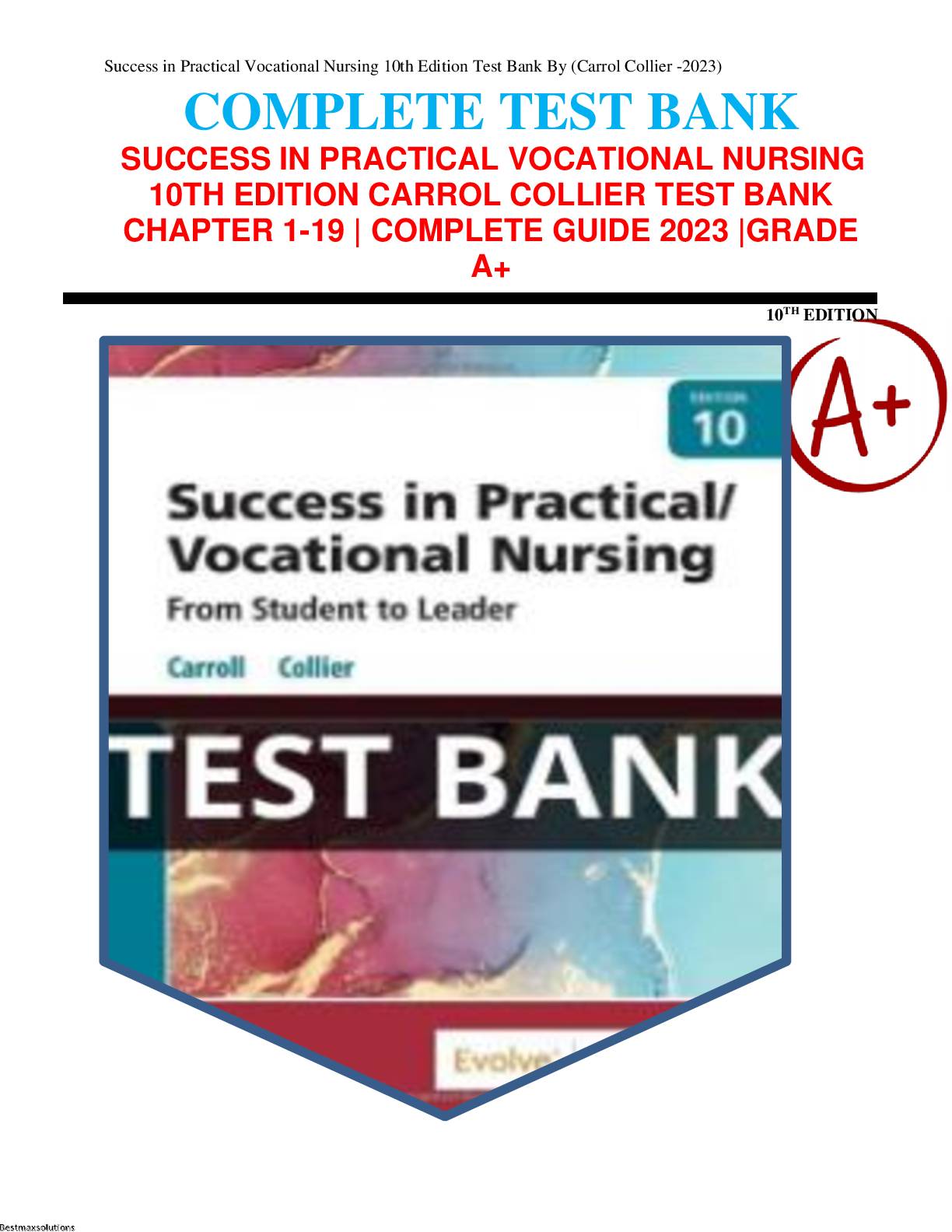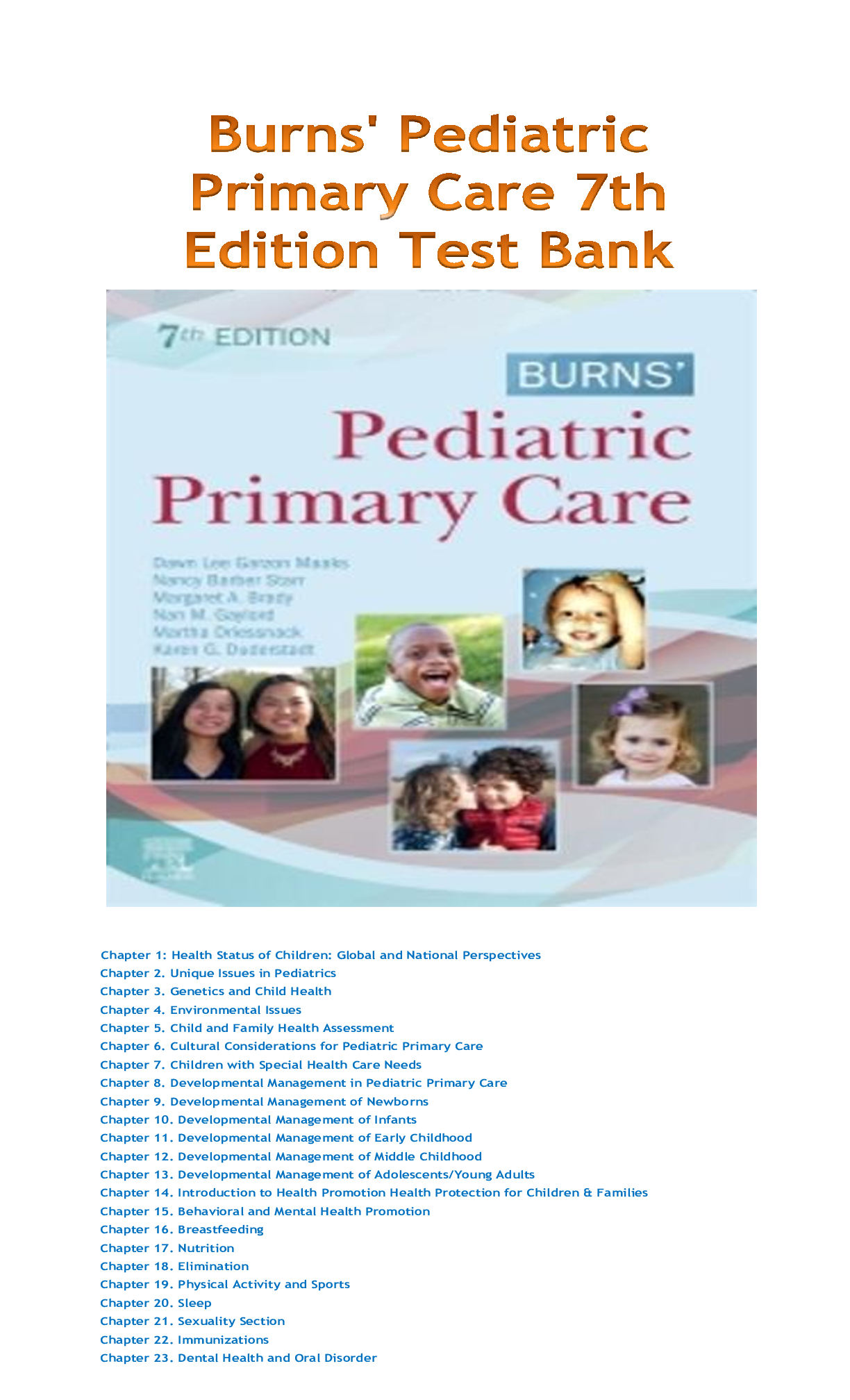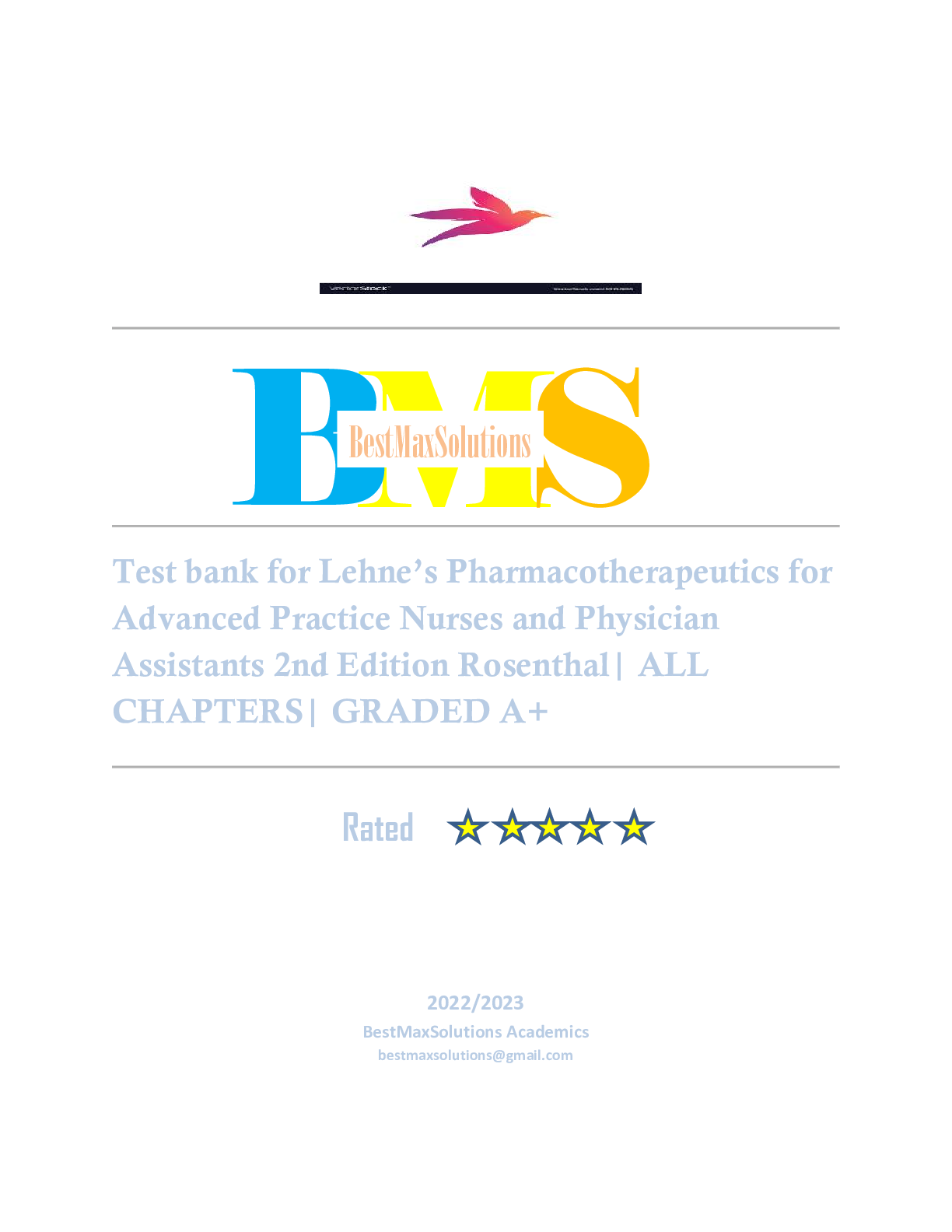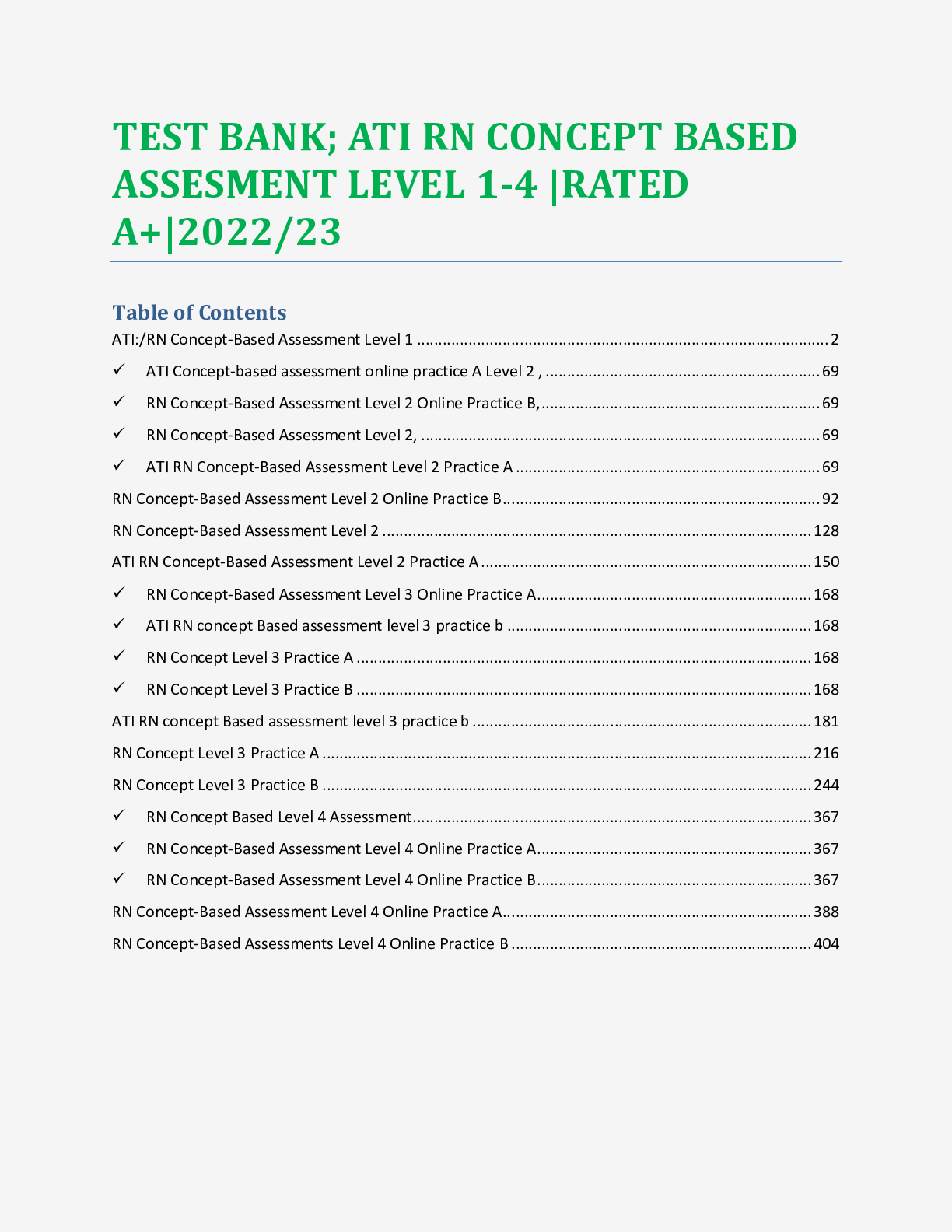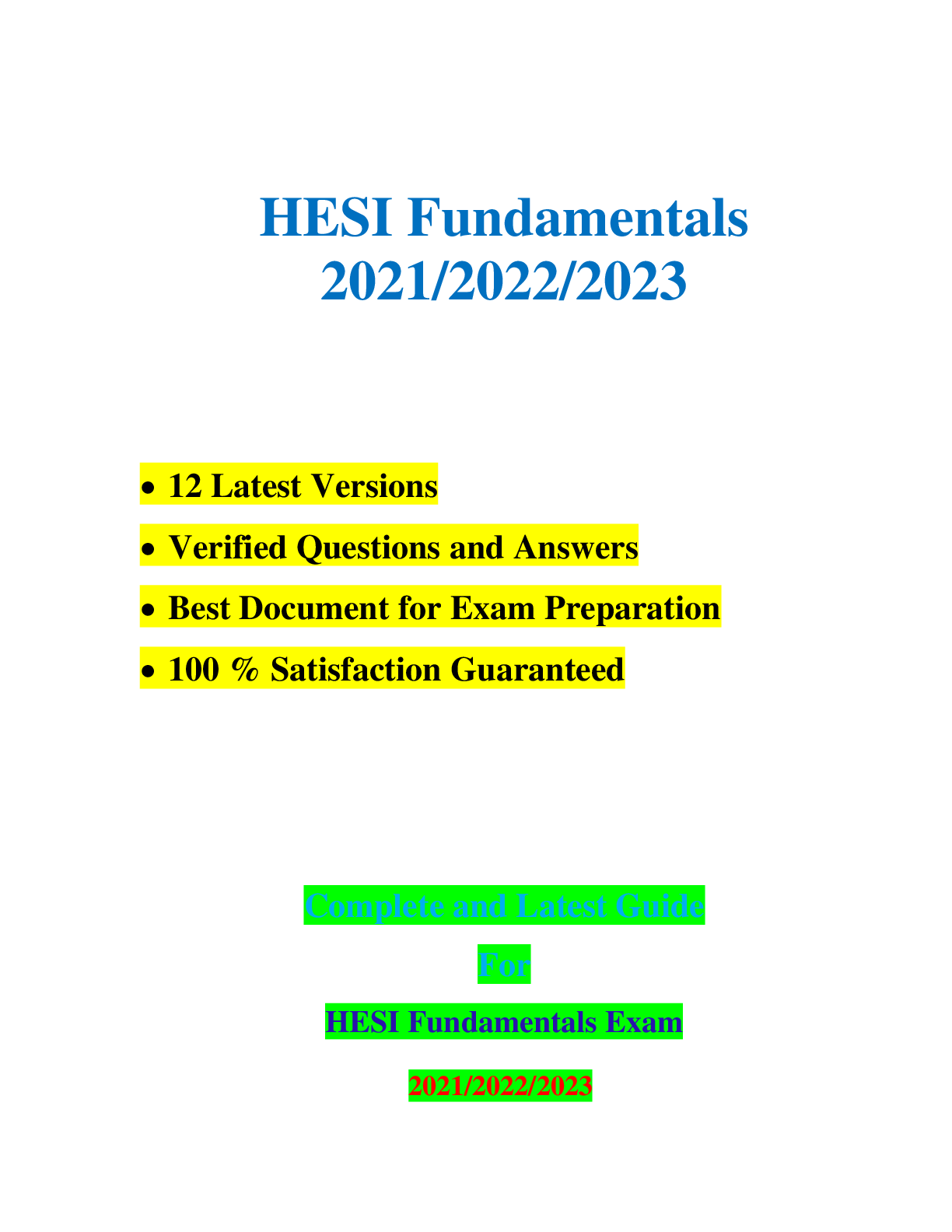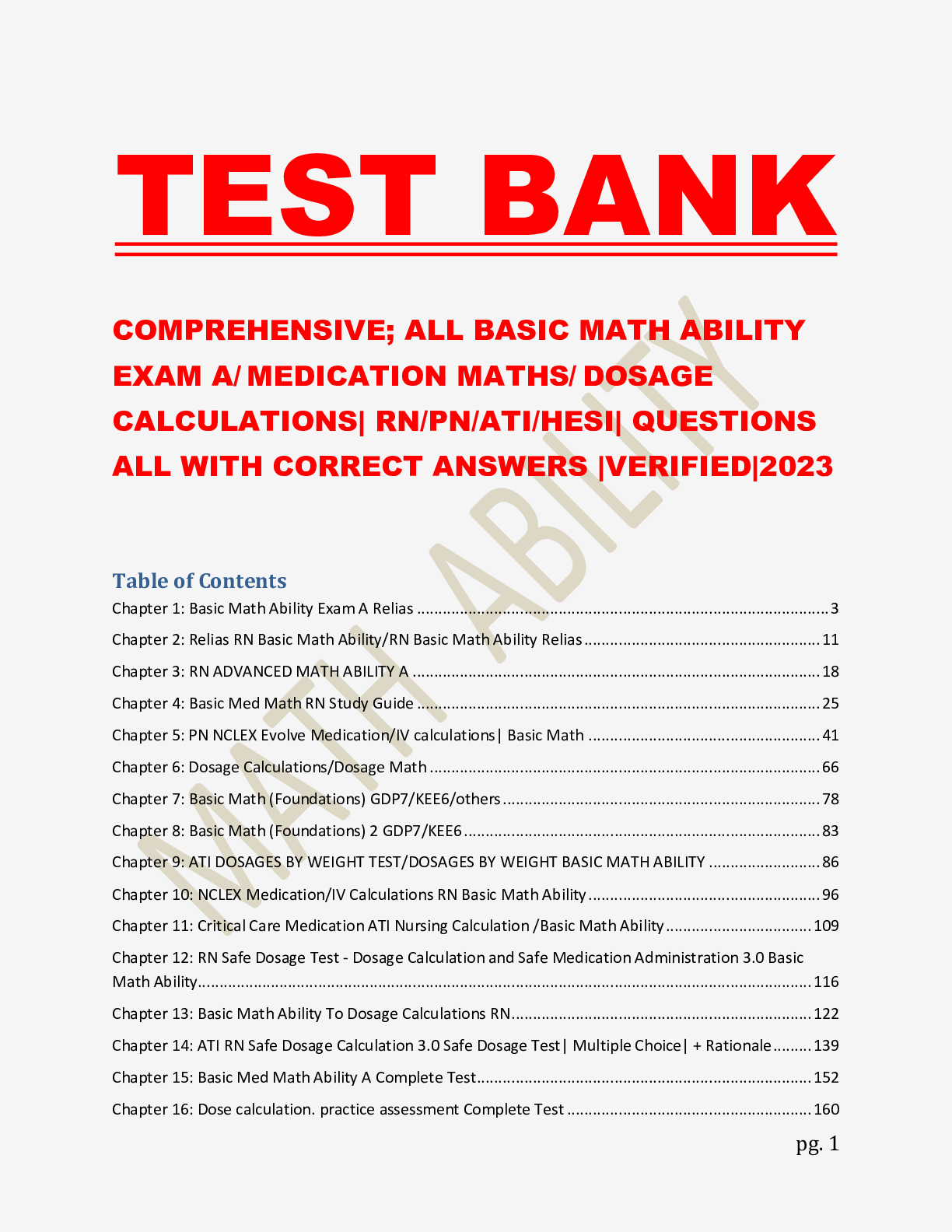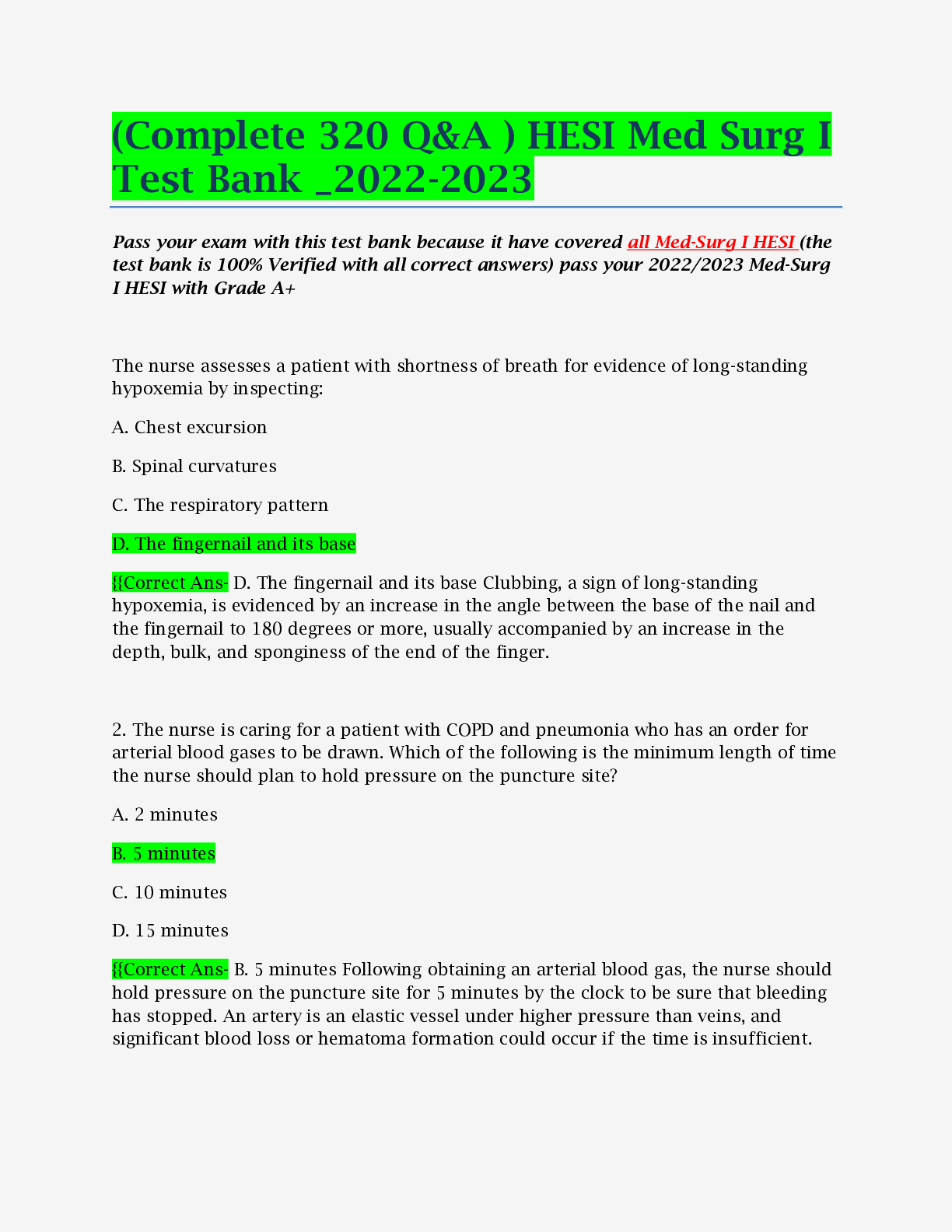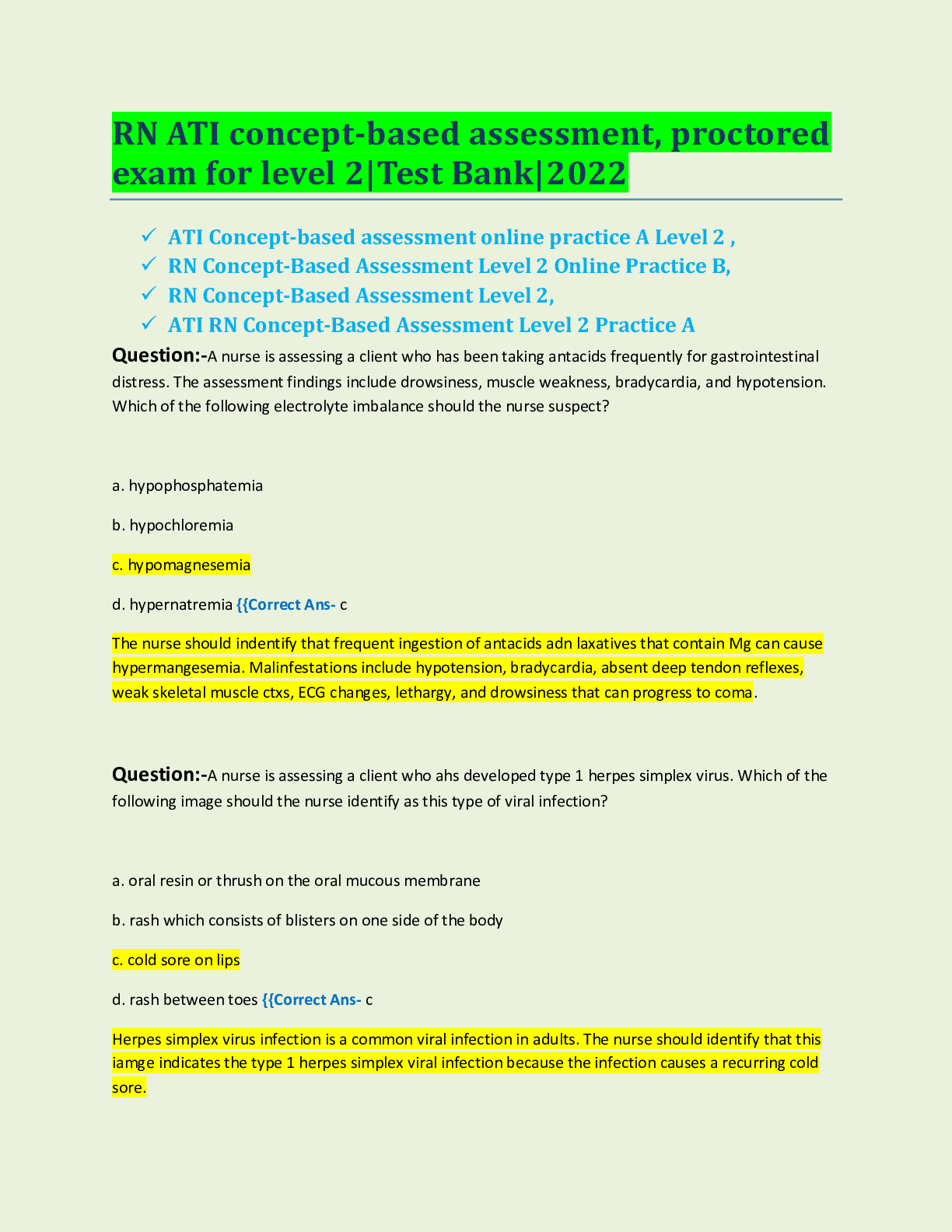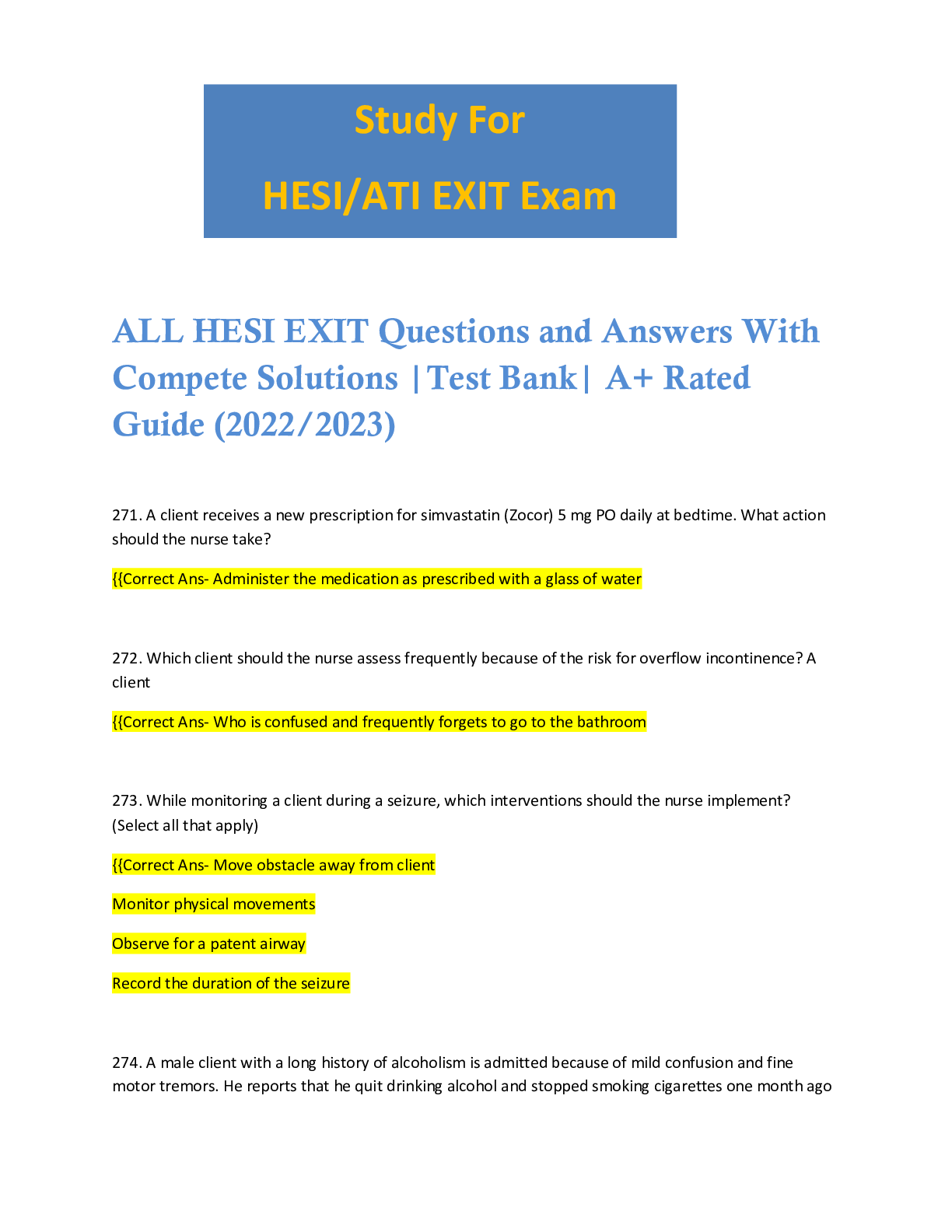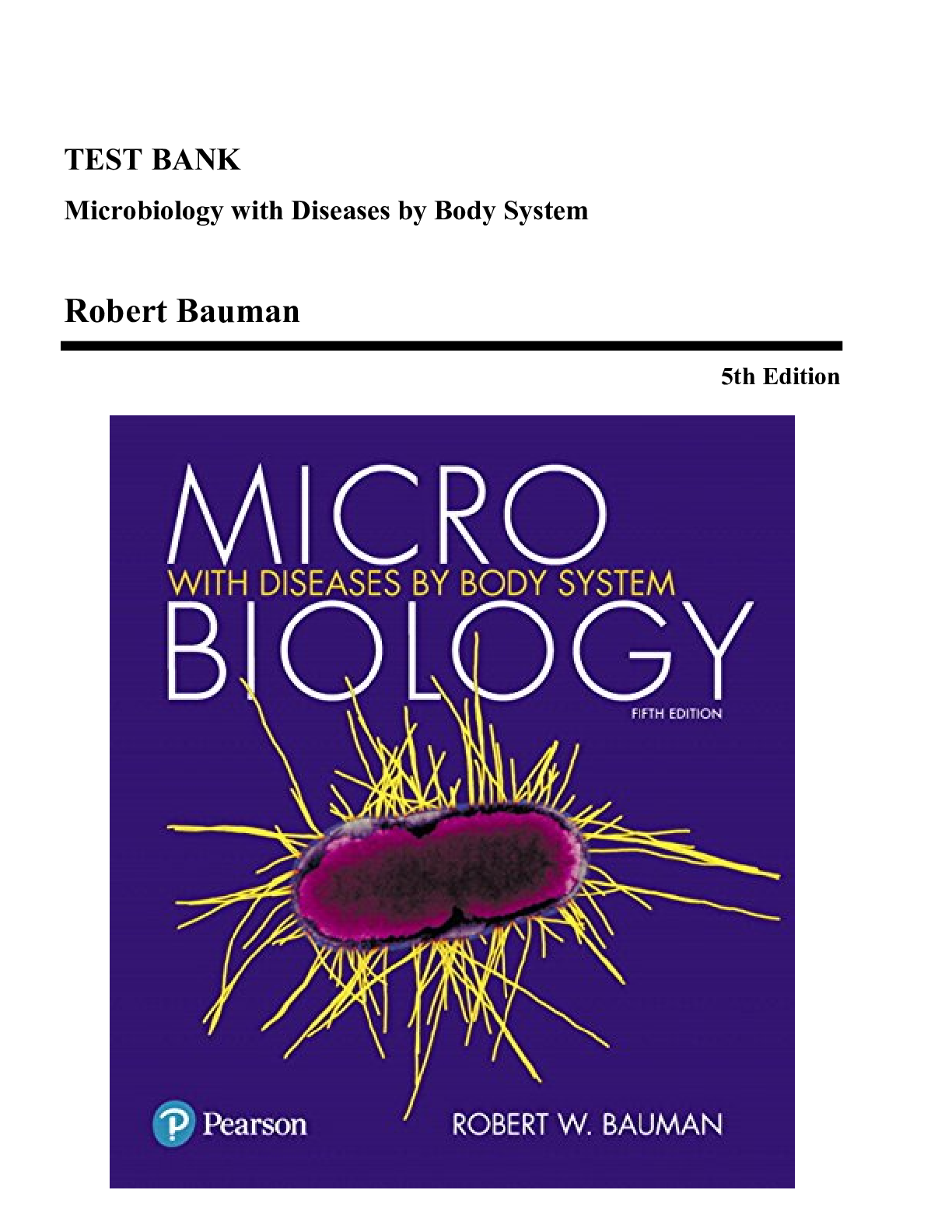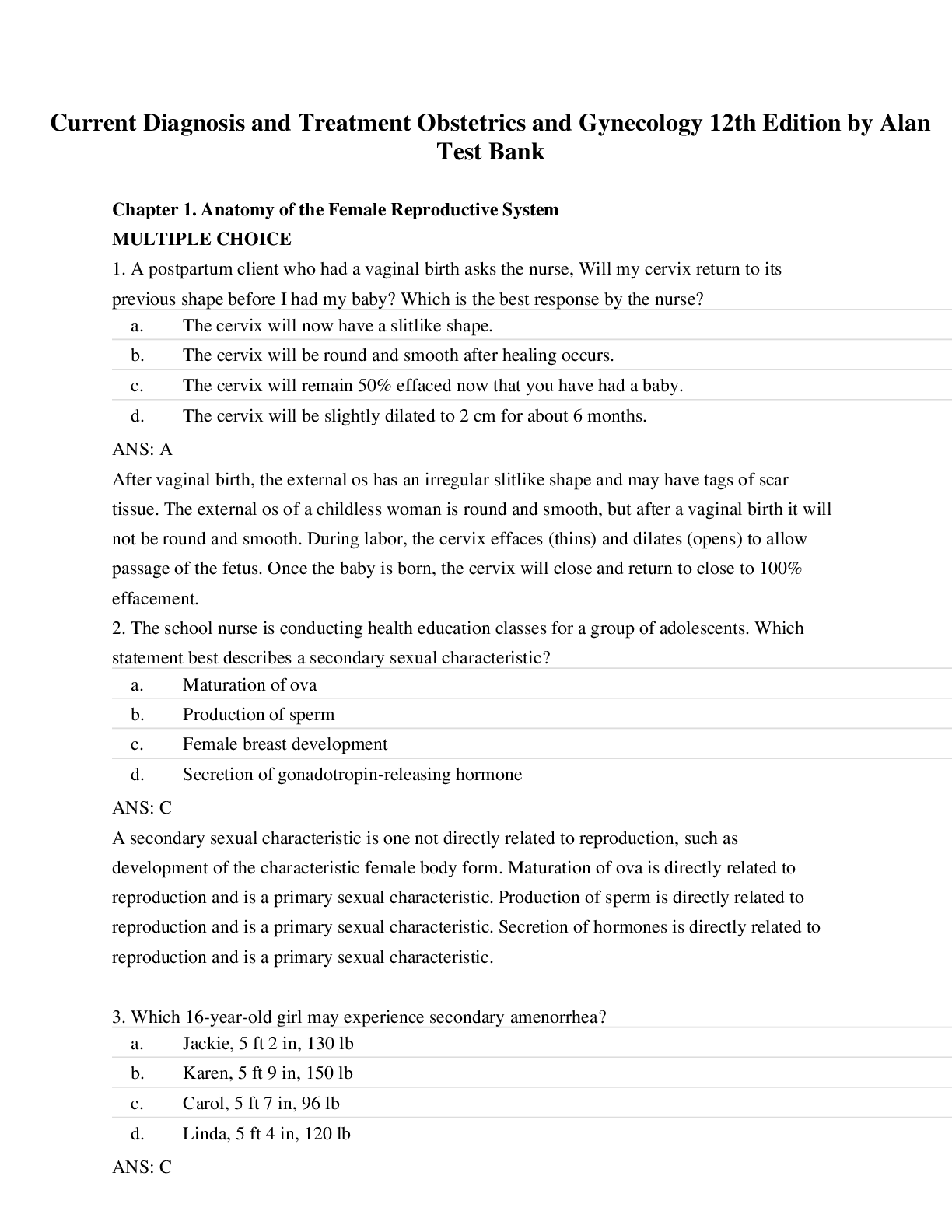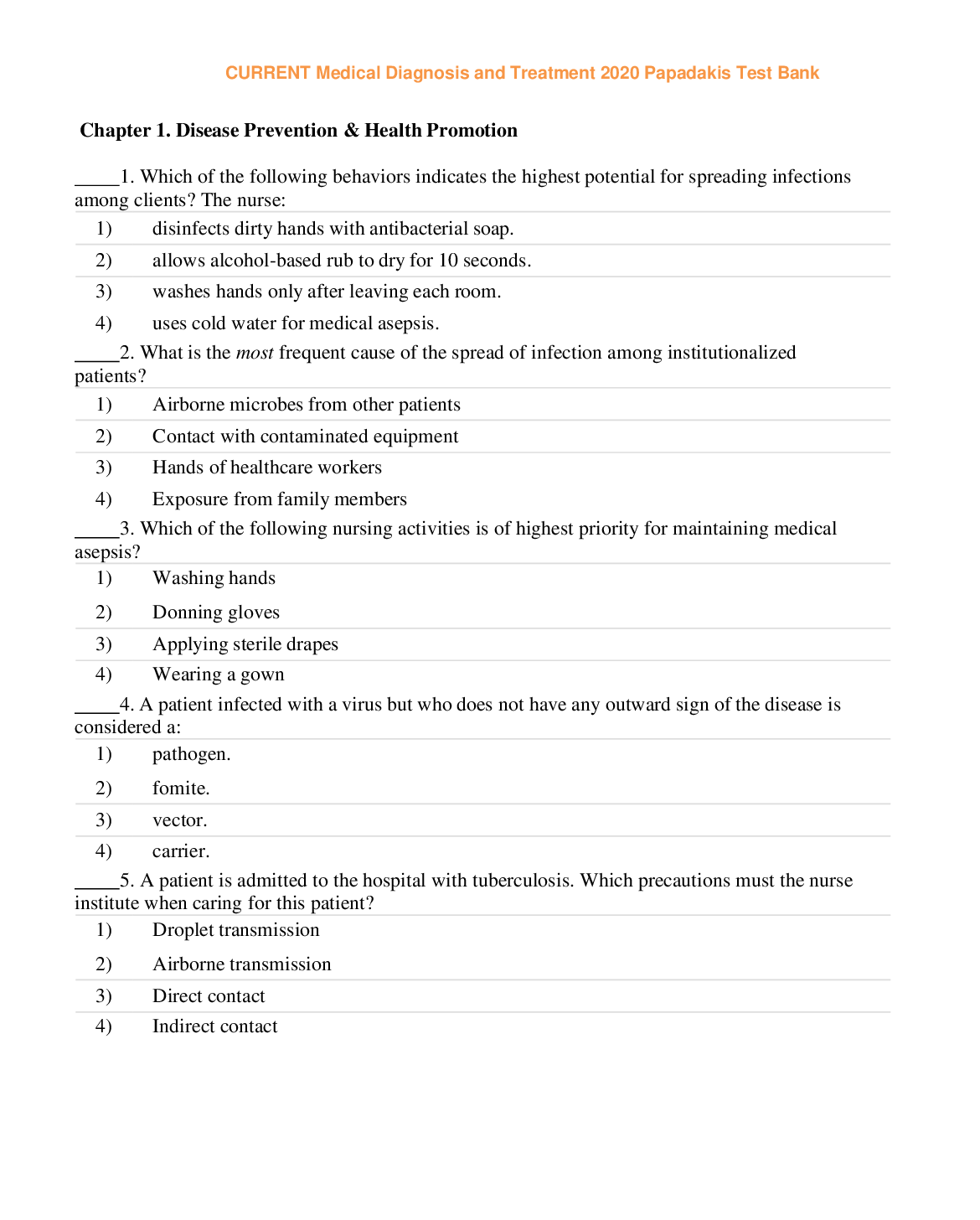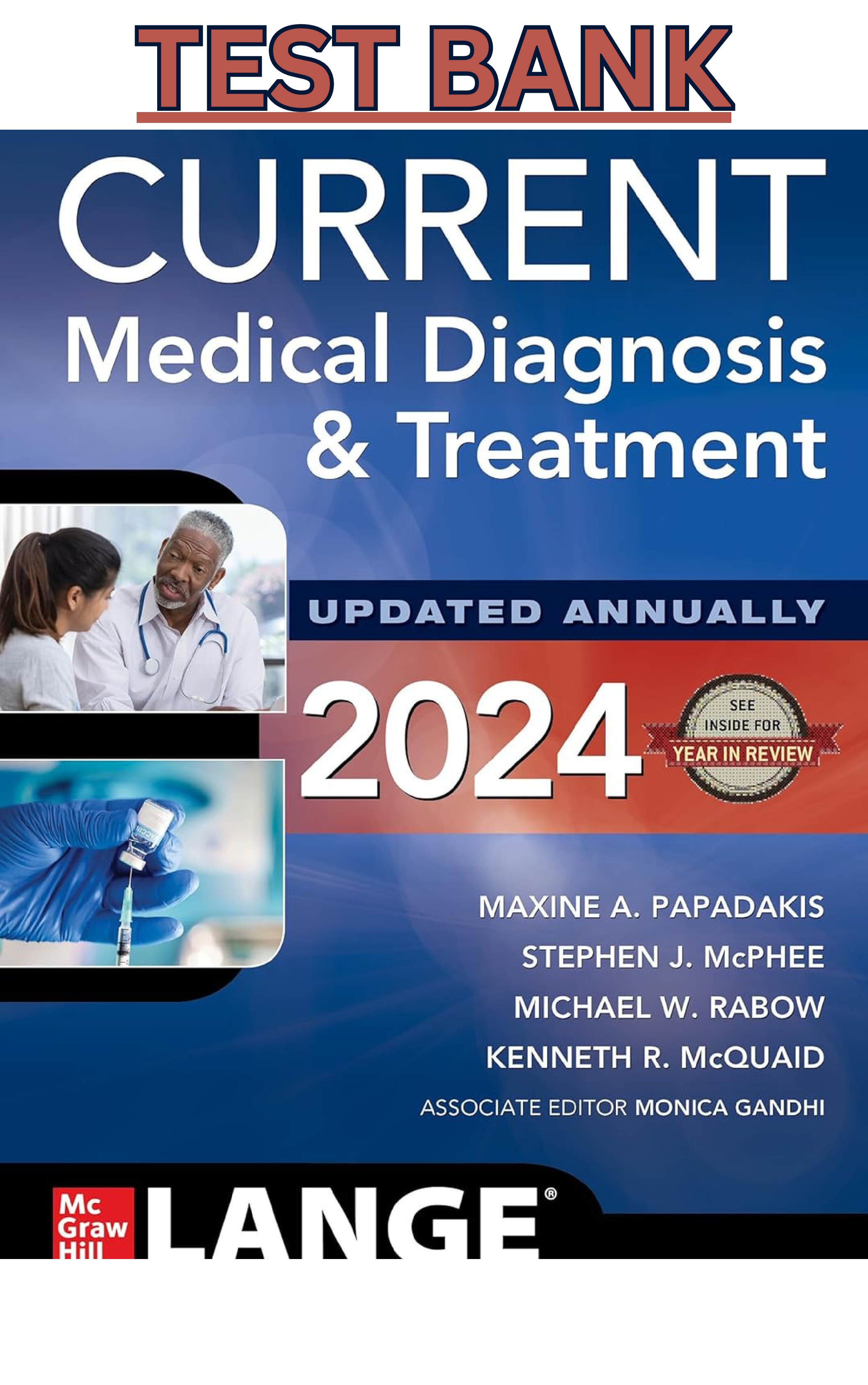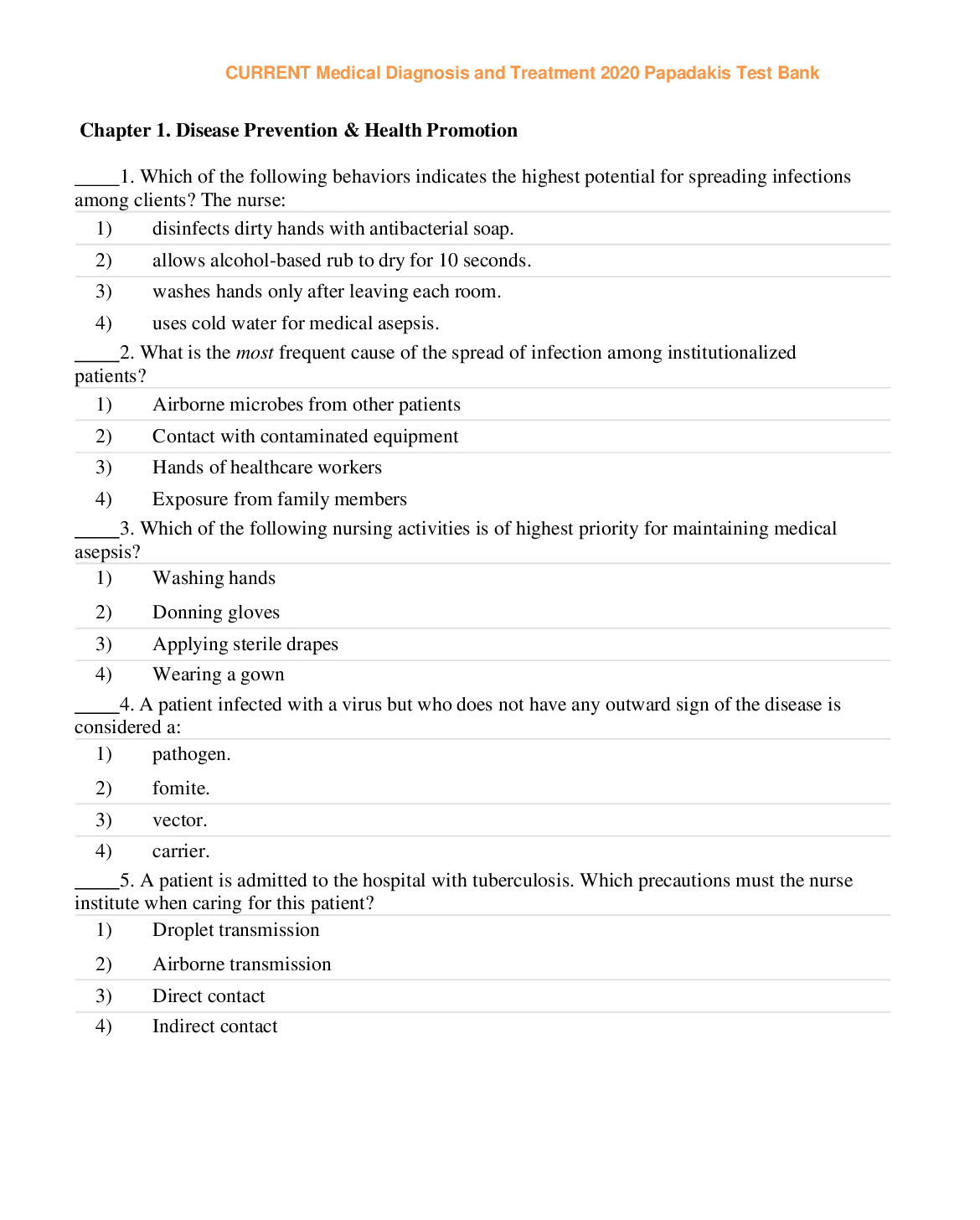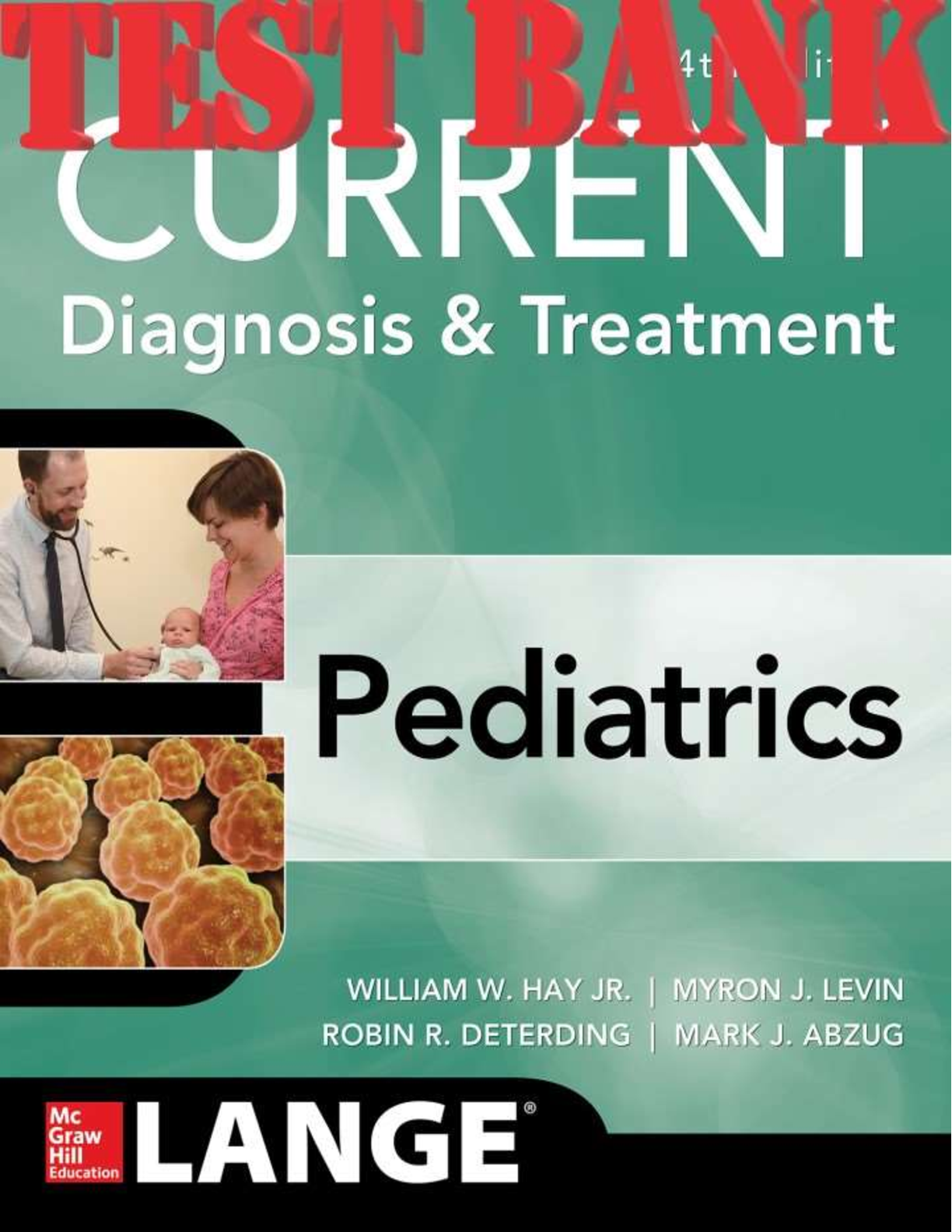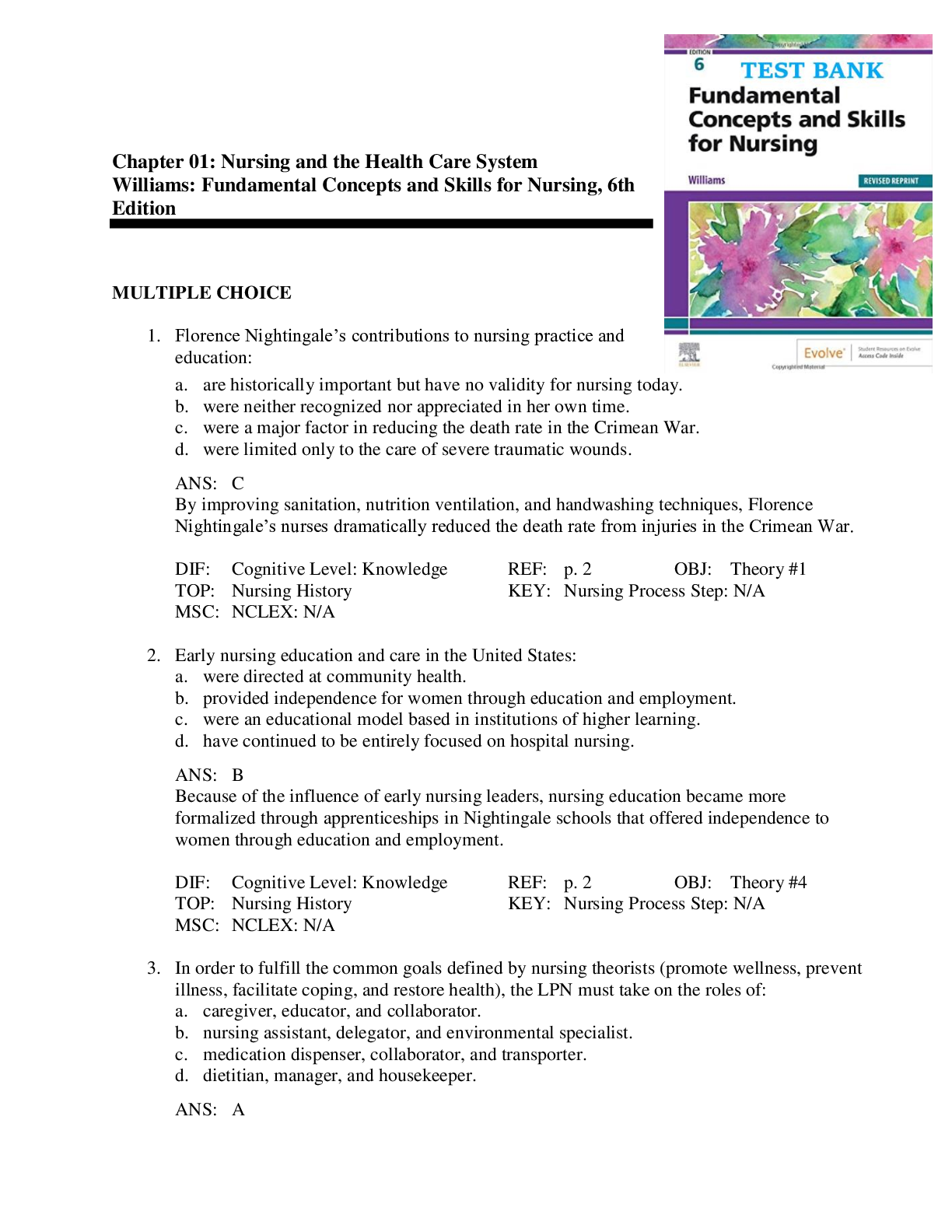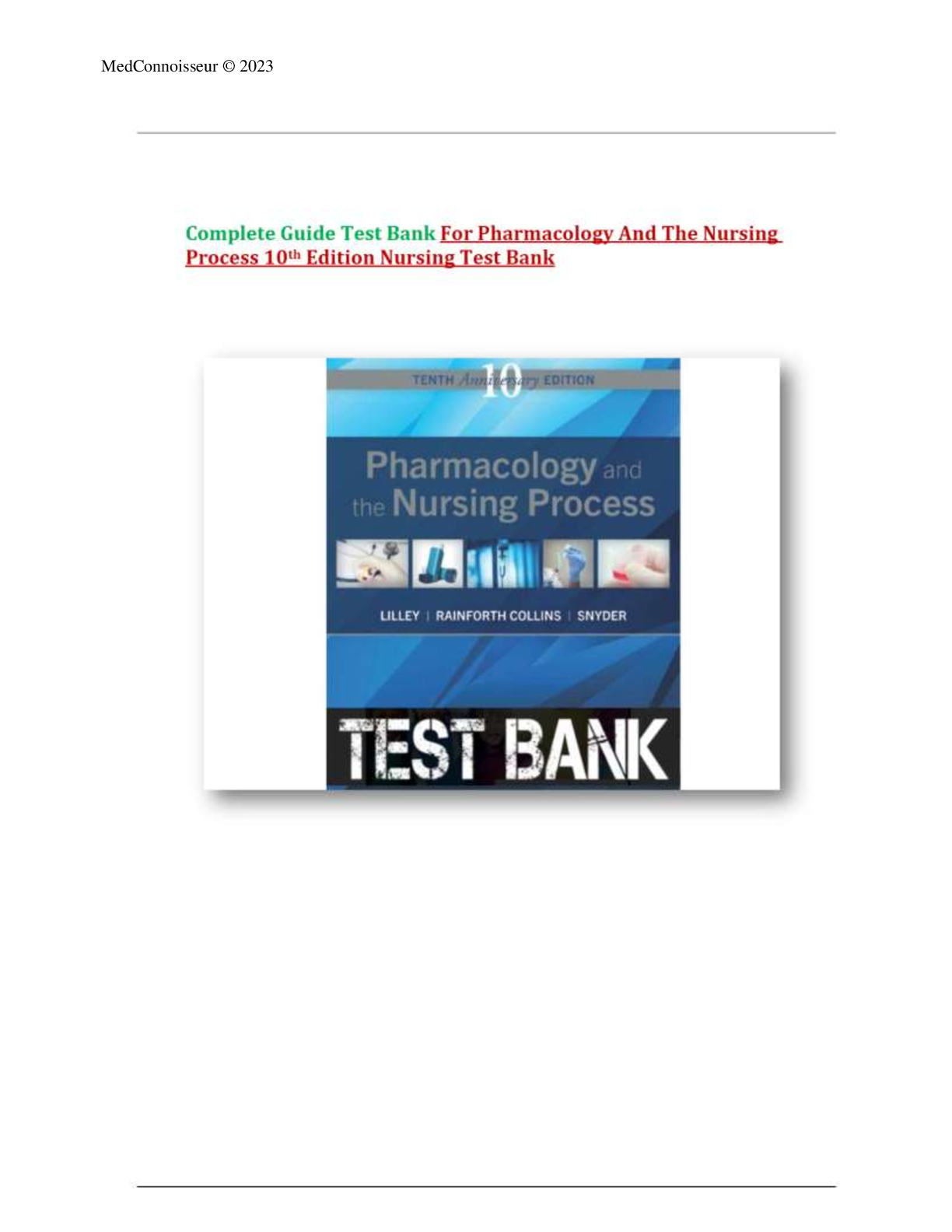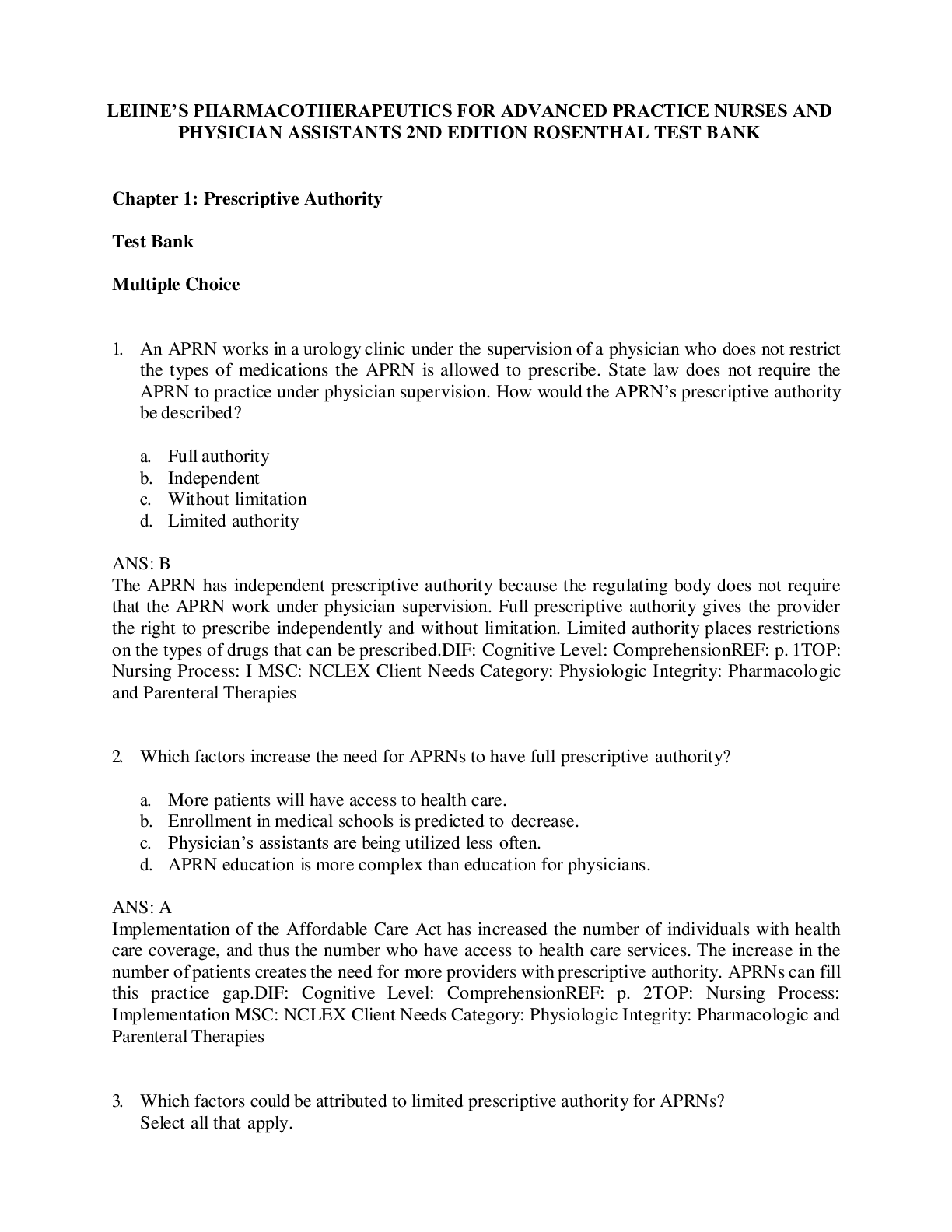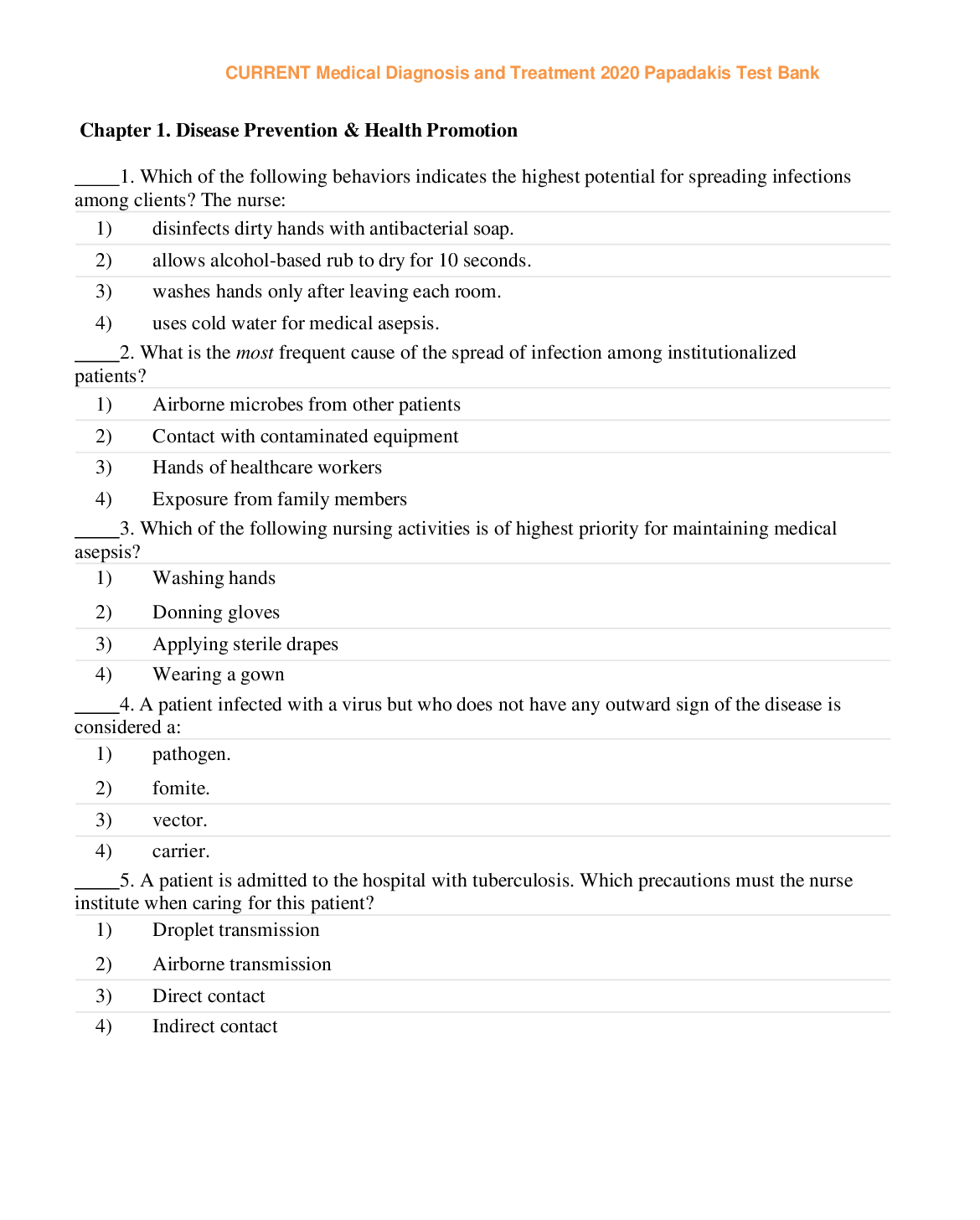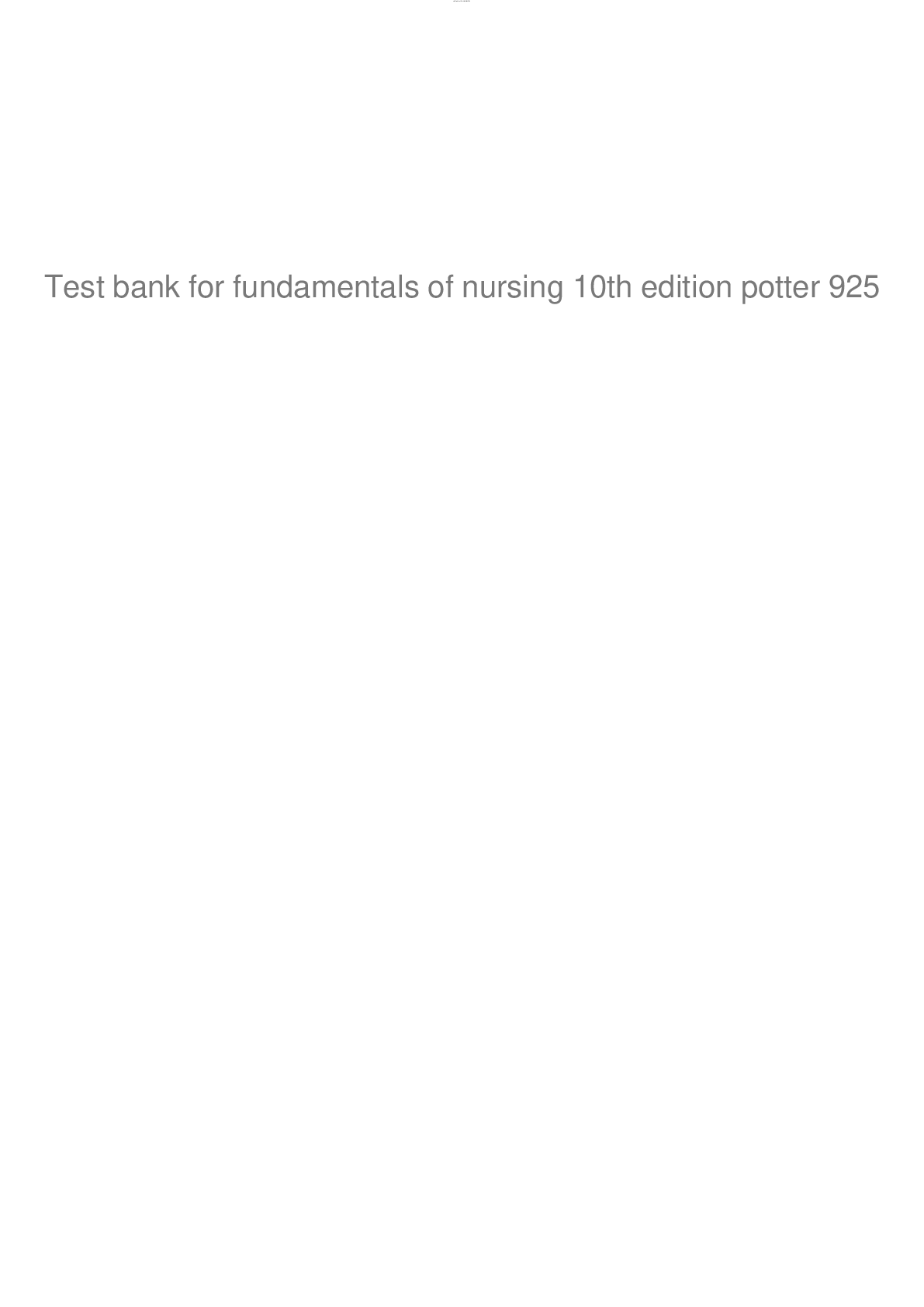*NURSING > TEST BANK > Test Bank For Current Medical Diagnosis And Treatment 2023 62nd Edition By By Maxine Papadakis, Step (All)
Test Bank For Current Medical Diagnosis And Treatment 2023 62nd Edition By By Maxine Papadakis, Stephen Mcphee, Michael Rabow & Kenneth Mcquaid / Complete Guide A+
Document Content and Description Below
Test Bank For Current Medical Diagnosis And Treatment 2023 62nd Edition By By Maxine Papadakis, Stephen Mcphee, Michael Rabow & Kenneth Mcquaid Sample 10. A mother of three young children is newly dia... gnosed with breast cancer. She is intensely committed to fighting the cancer. She believes she can control her cancer to some degree with a positive attitude and feelings of inner strength. Which of the following traits is she demonstrating that is linked to health and healing? 1) Invincibility 2) Hardiness 3) Baseline strength 4) Vulnerability Multiple Response Identify one or more choices that best complete the statement or answer the question. 1. The World Health Organizations definition of health includes which of the following? Choose all that apply. 1) Absence of disease 2) Physical well-being 3) Mental well-being 4) Social well-being 2. According to Penders health promotion model, which variables must be considered when planning a health promotion program for a client? Choose all that apply. 1) Individual characteristics and experiences 2) Levels of prevention 3) Behavioral outcomes 4) Behavior-specific cognitions and affect 3. Goals for Healthy People 2020 include which of the following? Choose all that apply. 1) Eliminate health disparities among various groups. 2) Decrease the cost of healthcare related to tobacco use. 3) Increase the quality and years of healthy life. 4) Decrease the number of inpatient days annually. 4. The nurse is implementing a wellness program based on data gathered from a group of low-income seniors living in a housing project. He is using the Wheels of Wellness as a model for his planned interventions. Which of the following interventions would be appropriate based on this model? Choose all that apply. 1) Creating a weekly discussion group focused on contemporary news 2) Facilitating a relationship between local pastors and residents of subsidized housing 3) Coordinating a senior tutorial program for local children at the housing center 4) Establishing an on-site healthcare clinic operating one day per week 5. The nurse working in an ambulatory care program asks questions about the clients locus of control as a part of his assessment because of which of the following? Choose all that apply. 1) People who feel in charge of their own health are the easiest to motivate toward change. 2) People who feel powerless about preventing illness are least likely to engage in health promotion activities. 3) People who respond to direction from respected authorities often prefer a health promotion program that is supervised by a health provider. 4) People who feel in charge of their own health are less motivated by health promotion activities. 6. Health promotion programs assist a person to advance toward optimal health. Which of the following activities might such programs include? Choose all that apply. 1) Disseminating information 2) Changing lifestyle and behavior 3) Prescribing medications to treat underlying disorders 4) 7. Environmental control programs Which of the following actions demonstrate how nurses promote health? 1) Role modeling 2) Educating patients and families 3) Counseling 4) Providing support Completion Complete each statement. 1. A middle-aged woman performs breast self-examination monthly. This intervention is considered to be prevention. 2. refers to nursing actions performed to help clients to achieve an optimal state of health. 3. What is the name of the nursing theorist who defines health as having three elements: a high level of overall physical, mental, and social functioning; a general adaptive-maintenance level of daily functioning; and the absence of illness (or the presence of efforts that lead to its absence)? Chapter 1. Health Promotion (Part 2) Answer Section MULTIPLE CHOICE 1. ANS: 4 Although health promotion and health protection may involve the same activities, their difference lies in the motivation for action. Health protection is motivated by a desire to avoid illness. Health promotion is motivated by the desire to increase wellness. Smoking cessation may also be a wellness behavior and may be considered a step toward healthy living; however, neither of these addresses motivation for action. Comprehension 2. ANS: 3 Prochaska and Diclemente identified four stages of change: the contemplation stage, the determination stage, the action stage, and the maintenance stage. This patient demonstrates behaviors typical of the action stage. If a participant exits a program before the end of the maintenance stage, relapse is likely to occur as the individual resumes his previous life style. 3. ANS: 3 Field tests for running are good for children and can be utilized when assessing cardiorespiratory fitness. The step test is appropriate for adults. The 12-inch bench height is too high for young children. The sit-and-reach test as well as range-of-motion exercises would be appropriate when assessing flexibility. 4. ANS: 1 Leavell and Clark identified three levels of activities for health protection: primary, secondary, and tertiary. Interventions are classified according to the point in the disease process in which they occur. 5. ANS: 3 Muscle strength measures the amount of weight a muscle (or group of muscles) can move at one time. This is recorded as a ratio of weight pushed (or lifted) divided by body weight. A woman weighing 132 pounds who is able to lift 72 pounds has a ratio of 72 divided by 132, or 0.55. 6. ANS: 2 Heavy and chronic use of alcohol and use of illicit drugs increase the risk of disease and injuries and intentional death (suicide and homicide). Although alcohol as a depressant slows metabolism, chronic alcohol use is more likely associated with poor nutrition, which may or may not lead to obesity. Chronic alcohol use causes damage to liver cells over time in the later years. Alcohol intake is often associated with tobacco and recreational drug use; however, the risk of unintentional injury, such as car accident, suicide, or violence, is more concerning than smoking. 7. ANS: 3 Primary prevention activities are designed to prevent or slow the onset of disease. Activities such as eating healthy foods, exercising, wearing sunscreen, obeying seat-belt laws, and getting immunizations are examples of primary level interventions. Secondary prevention activities detect illness so it can be treated in the early stages. Tertiary prevention focuses on stopping the disease from progressing and returning the individual to the pre-illness phase. The patient has an established disease and is receiving care to stop the disease from progressing. 8. ANS: 1 Health screening activities are designed to detect disease at an early stage so that treatment can begin before there is an opportunity for disease to spread or become debilitating. 9. ANS: 1 The American Academy of Pediatrics take a targeted approach, recommending that overweight children receive cholesterol screening, regardless of family history or other risk factors for cardiovascular disease. The American Heart Association recommends that all adults age 20 years or older have a fasting lipid panel at least once every 5 years. If total cholesterol is 200 mg/dL or greateror HDL is less than 40 mg/dLfrequent monitoring is required. 10. ANS: 2 Research has also demonstrated that in the face of difficult life events, some people develop hardiness rather than vulnerability. Hardiness is a quality in which an individual experiences high levels of stress yet does not fall ill. There are three general characteristics of the hardy person: control (belief in the ability to control the experience), commitment (feeling deeply involved in the activity producing stress), and challenge (the ability to view the change as a challenge to grow). These traits are associated with a strong resistance to negative feelings that occur under adverse circumstances. MULTIPLE RESPONSE 1. ANS: 2, 3, 4 The World Health Organization defines health as a state of complete physical, mental, and social well-being, not merely the absence of disease of infirmity. 2. ANS: 1, 3, 4 Pender identified three variables that affect health promotion: individual characteristics and experiences, behavior-specific cognitions and affect, and behavioral outcomes. Levels of prevention were identified by Leavell and Clark; three levels relate to health protection. The levels differ based on their timing in the illness cycle. 3. ANS: 1, 3 The four overarching goals of Healthy People 2020 are to 1) increase the quality and years of healthy life, free of disease, injury, and premature death, 2) eliminate health disparities and improve health for all groups of people, 3) create physical and social environments for people to live a healthy life, and 4) promote healthy development for people in all stages of life. 4. ANS: 1, 2, 3, 4 The Wheels of Wellness model identifies the following dimensions of health: emotional, intellectual, physical, spiritual, social/family, and occupational. A weekly discussion group stimulates intellectual health. A relationship between local pastors and those living in subsidized housing creates a climate for spiritual health. A tutorial program offered by seniors to local children will facilitate occupational health. An on-site healthcare clinic addresses physical health. 5. ANS: 1, 2, 3 Identifying a persons locus of control helps the nurse determine how to approach a client about health promotion. People who feel powerless about preventing illness are least likely to engage in health promotion activities. People who respond to direction from respected authorities often prefer a health promotion program that is supervised by a health provider. Clients who feel in charge of their own health are the easiest to motivate toward positive change. 6. ANS: 1, 2, 4 Health promotion programs may be categorized into four types: disseminating information; programs for changing lifestyle and behavior; environmental control programs; and wellness appraisal and health risk assessment programs. Prescribing medications to treat underlying disorders is an activity that fosters health focused at an individual level rather than at a group program level. 7. ANS: 1, 2, 3, 4 Nurses promote health by acting as role models, counseling, providing health education, and providing and facilitating support. 1. ANS: secondary Secondary prevention activities detect illness so that it can be treated in the early stages. Health activities such as mammograms, testicular examinations, regular physical examinations, blood pressure and diabetes screenings, and tuberculosis skin tests are examples of secondary interventions. Primary prevention activities are designed to prevent or slow the onset of disease and promote health. Activities such as eating healthy foods, exercising, wearing sunscreen, obeying seat-belt laws, and getting immunizations are examples of primary level interventions. Tertiary prevention focuses on stopping the disease from progressing and returning the individual to the pre-illness phase. Chapter 2. Common Symptoms 1. The nurse is listening to the breath sounds of a patient with severe asthma. Air passing through narrowed bronchioles would produce which of these adventitious sounds? a. Wheezes b. Bronchial sounds c. Bronchophony d. Whispered pectoriloquy ANS: A Wheezes are caused by air squeezed or compressed through passageways narrowed almost to closure by collapsing, swelling, secretions, or tumors, such as with acute asthma or chronic emphysema. 2. A mother brings her 3-month-old infant to the clinic for evaluation of a cold. She tells the nurse that he has had a runny nose for a week. When performing the physical assessment, the nurse notes that the child has nasal flaring and sternal and intercostal retractions. The nurses next action should be to: a. Assure the mother that these signs are normal symptoms of a cold. b. Recognize that these are serious signs, and contact the physician. c. Ask the mother if the infant has had trouble with feedings. d. Perform a complete cardiac assessment because these signs are probably indicative of early heart failure. ANS: B The infant is an obligatory nose breather until the age of 3 months. Normally, no flaring of the nostrils and no sternal or intercostal retraction occurs. Significant retractions of the sternum and intercostal muscles and nasal flaring indicate increased inspiratory effort, as in pneumonia, acute airway obstruction, asthma, and atelectasis; therefore, immediate referral to the physician is warranted. These signs do not indicate heart failure, and an assessment of the infants feeding is not a priority at this time. 3. A teenage patient comes to the emergency department with complaints of an inability to breathe and a sharp pain in the left side of his chest. The assessment findings include cyanosis, tachypnea, tracheal deviation to the right, decreased tactile fremitus on the left, hyperresonance on the left, and decreased breath sounds on the left. The nurse interprets that these assessment findings are consistent with: a. Bronchitis. b. Pneumothorax. c. Acute pneumonia. d. Asthmatic attack. ANS: B With a pneumothorax, free air in the pleural space causes partial or complete lung collapse. If the pneumothorax is large, then tachypnea and cyanosis are evident. Unequal chest expansion, decreased or absent tactile fremitus, tracheal deviation to the unaffected side, decreased chest expansion, hyperresonant percussion tones, and decreased or absent breath sounds are found with the presence of pneumothorax. 4. The nurse has just recorded a positive iliopsoas test on a patient who has abdominal pain. This test is used to confirm a(n): a. Inflamed liver. b. Perforated spleen. c. Perforated appendix. d. Enlarged gallbladder. ANS: C An inflamed or perforated appendix irritates the iliopsoas muscle, producing pain in the RLQ. 5. Which statement indicates that the nurse understands the pain experienced by an older adult? a. Older adults must learn to tolerate pain. b. Pain is a normal process of aging and is to be expected. c. Pain indicates a pathologic condition or an injury and is not a normal process of aging. d. Older individuals perceive pain to a lesser degree than do younger individuals. ANS: C Pain indicates a pathologic condition or an injury and should never be considered something that an older adult should expect or tolerate. Pain is not a normal process of aging, and no evidence suggests that pain perception is reduced with aging. 6. In assessing the tonsils of a 30 year old, the nurse notices that they are involuted, granular in appearance, and appear to have deep crypts. What is correct response to these findings? a. Refer the patient to a throat specialist. b. No response is needed; this appearance is normal for the tonsils. c. Continue with the assessment, looking for any other abnormal findings. d. Obtain a throat culture on the patient for possible streptococcal (strep) infection. ANS: B The tonsils are the same color as the surrounding mucous membrane, although they look more granular and their surface shows deep crypts. Tonsillar tissue enlarges during childhood until puberty and then involutes. 7. The nurse is obtaining a health history on a 3-month-old infant. During the interview, the mother states, I think she is getting her first tooth because she has started drooling a lot. The nurses best response would be: a. Youre right, drooling is usually a sign of the first tooth. b. It would be unusual for a 3 month old to be getting her first tooth. c. This could be the sign of a problem with the salivary glands. d. She is just starting to salivate and hasnt learned to swallow the saliva. ANS: D In the infant, salivation starts at 3 months. The baby will drool for a few months before learning to swallow the saliva. This drooling does not herald the eruption of the first tooth, although many parents think it does. 8. The nurse is assessing an 80-year-old patient. Which of these findings would be expected for this patient? a. Hypertrophy of the gums b. Increased production of saliva c. Decreased ability to identify odors d. Finer and less prominent nasal hair ANS: C The sense of smell may be reduced because of a decrease in the number of olfactory nerve fibers. Nasal hairs grow coarser and stiffer with aging. The gums may recede with aging, not hypertrophy, and saliva production decreases. 9. The nurse is palpating the sinus areas. If the findings are normal, then the patient should report which sensation? a. No sensation b. Firm pressure c. Pain during palpation d. Pain sensation behind eyes ANS: B The person should feel firm pressure but no pain. Sinus areas are tender to palpation in persons with chronic allergies or an acute infection (sinusitis). 10. A 60-year-old man has just been told that he has benign prostatic hypertrophy (BPH). He has a friend who just died from cancer of the prostate. He is concerned this will happen to him. How should the nurse respond? a. The swelling in your prostate is only temporary and will go away. b. We will treat you with chemotherapy so we can control the cancer. c. It would be very unusual for a man your age to have cancer of the prostate. d. The enlargement of your prostate is caused by hormonal changes, and not cancer. ANS: D The prostate gland commonly starts to enlarge during the middle adult years. BPH is present in 1 in 10 men at the age of 40 years and increases with age. It is believed that the hypertrophy is caused by hormonal imbalance that leads to the proliferation of benign adenomas. The other responses are not appropriate. 11. A patient reports excruciating headache pain on one side of his head, especially around his eye, forehead, and cheek that has lasted approximately to 2 hours, occurring once or twice each day. The nurse should suspect: a. Hypertension. b. Cluster headaches. c. Tension headaches. d. Migraine headaches. ANS: B Cluster headaches produce pain around the eye, temple, forehead, and cheek and are unilateral and always on the same side of the head. They are excruciating and occur once or twice per day and last to 2 hours each. 12. A patient says that she has recently noticed a lump in the front of her neck below her Adams apple that seems to be getting bigger. During the assessment, the finding that leads the nurse to suspect that this may not be a cancerous thyroid nodule is that the lump (nodule): a. Is tender. b. Is mobile and not hard. c. Disappears when the patient smiles. d. Is hard and fixed to the surrounding structures. ANS: BPainless, rapidly growing nodules may be cancerous, especially the appearance of a single nodule in a young person. However, cancerous nodules tend to be hard and fixed to surrounding structures, not mobile. Chapter 3. Preoperative Evaluation & Perioperative Management MULTIPLE CHOICE 1. The nurse is identifying diagnoses appropriate for a client scheduled for a surgical procedure. Which of the following is a diagnosis commonly used for preoperative client? 1. Anxiety 2. Sleep deprivation 3. Excess fluid volume 4. Disturbed body image ANS: 1 The preoperative experience may be one of the most tension-producing periods of hospitalization. The nursing diagnosis anxiety is commonly used for preoperative clients. The other diagnoses are not commonly used as preoperative diagnoses. 2. The preoperative nurse cares for the client until the client progresses into the intraoperative phase of care which begins when the client: 1. signs the surgical consent form. 2. arrives at the surgical suite doors. 3. is transferred to the postanesthesia care unit. 4. accepts that surgery is pending. ANS: 2 The preoperative period ends and the intraoperative period begins when the patient and family are at the door to the surgical suites. Intraoperative care does not begin when the client signs the surgical consent form, is transferred to the postanesthesia care unit, or accepts that surgery is pending. 3. The nurse is ensuring that a client is able to make knowledgeable decisions regarding an upcoming surgery and can provide informed consent. What is the responsibility of the nurse regarding informed consent? 1. Explain the surgical options 2. Explain the operative risks 3. Describe the operative procedure to be done 4. Witness a patients signature ANS: 4 The nurse may concurrently sign that he has witnessed a patients signature. It is the physicians responsibility to explain the other answer choices. PTS: 1 DIF: Apply REF: Decision Strategies and Informed Consent 4.A client being prepared for surgery has a pulse oximeter placed on one digit of his hand. The nurse is applying this device to monitor the clients: 1. oxygen level. 2. heart rate. 3. blood pressure. 4. urine output. ANS: 1 Pulse oximeters are used to precisely identify the clients peripheral tissue oxygenation. Pulse oximeters are not to measure heart rate, blood pressure, or urine output. PTS: 1 DIF: Analyze REF: Trends 5.A client is scheduled for surgery in 2 weeks. Which of the following should the nurse instruct the client regarding healthy lifestyle behaviors? 1. Eat nutritious meals. 2. If obese, cut calories before the surgery. 3. If sedentary, exercise more before the surgery. 4. Stop all prescribed medications. [Show More]
Last updated: 7 months ago
Preview 1 out of 448 pages

Reviews( 0 )
Document information
Connected school, study & course
About the document
Uploaded On
Sep 27, 2023
Number of pages
448
Written in
Additional information
This document has been written for:
Uploaded
Sep 27, 2023
Downloads
0
Views
97

